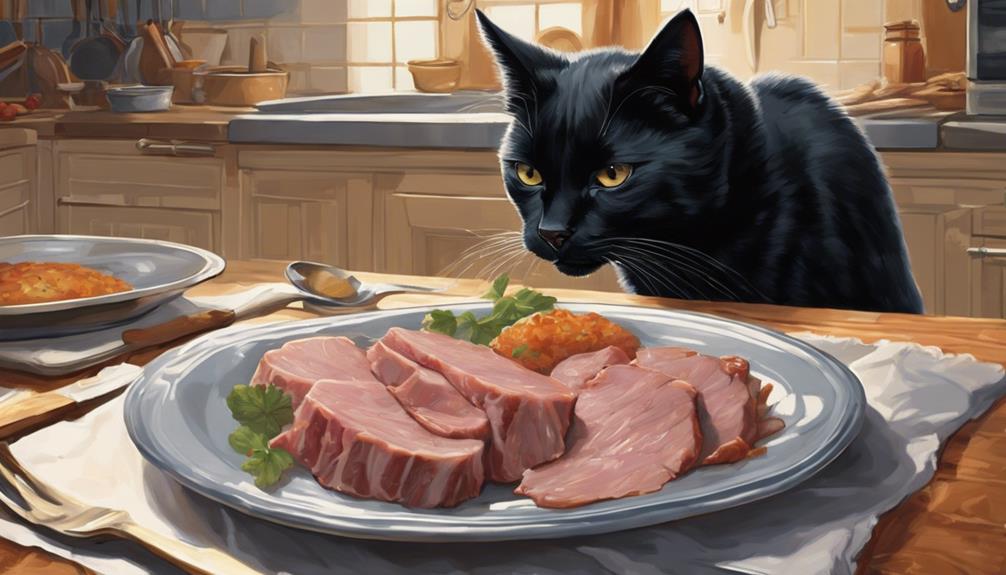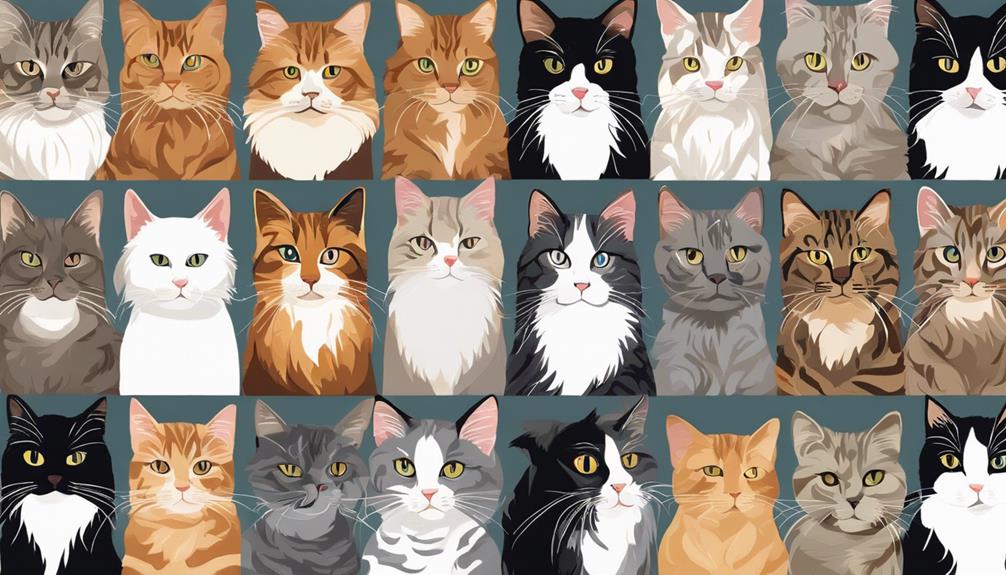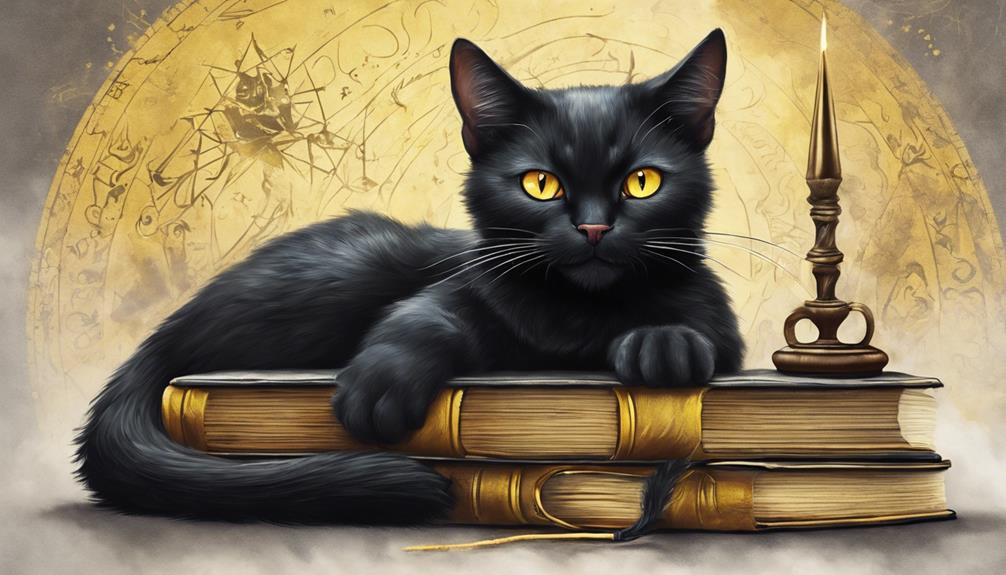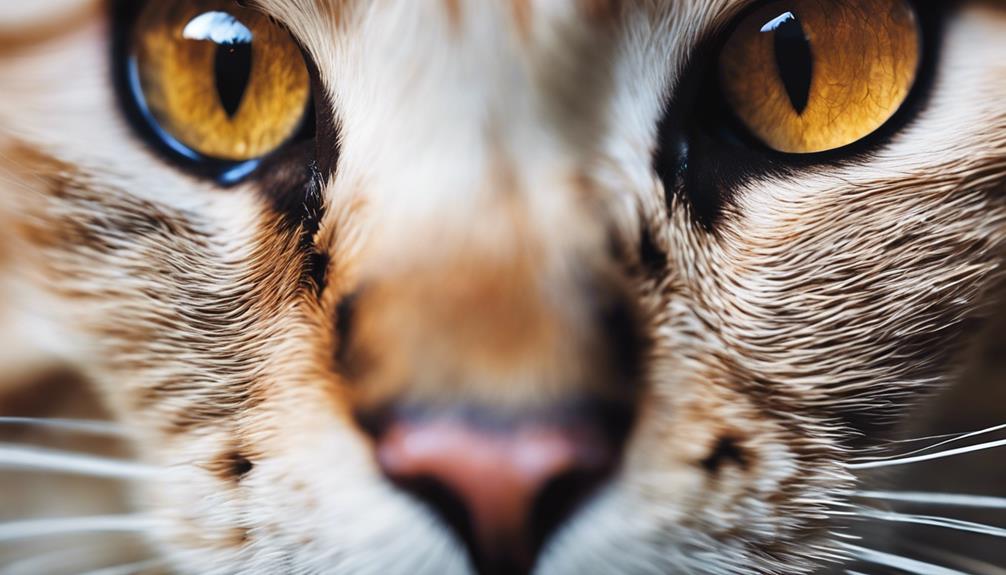Yes, cats can safely eat pork when properly cooked and in moderation. Pork can be high in fat and sodium, so lean cuts are best. Be cautious of toxic ingredients like onions and garlic, and avoid bones that can splinter. Fresh, organic pork is a healthy choice. Monitor portion sizes and potential allergic reactions. Cook pork fully to prevent harmful bacteria. Remember, moderation and care are key when evaluating a cat's pork consumption. Wondering about other factors to evaluate with cats and pork? There's more to uncover about cats' dietary needs and how pork fits in.
Key Takeaways
- Lean, fully cooked pork in moderation is safe for cats.
- Avoid raw pork to prevent parasitic infections and bacterial diseases.
- Monitor for allergies, reactions, and digestive issues.
- Opt for lean cuts without bones or seasonings.
- Consult a vet for safe portions and dietary advice.
Risks of Feeding Pork to Cats
Feeding pork to cats poses various risks that can harm their health and well-being. Cats are known for their picky eating habits, but when it comes to pork, it's important to be cautious. Pork can be detrimental to your cat due to its high fat content, leading to potential health issues. Regularly feeding pork to your feline friend can contribute to obesity, which is harmful to their overall well-being. Furthermore, raw pork can introduce parasitic infections and bacterial diseases, posing a significant threat to your cat's health.
Additionally, pork bones can splinter, causing choking hazards and digestive problems for cats. The high sodium content in pork can put stress on your cat's kidneys, liver, and heart, leading to various health complications. Even toxic ingredients like onions and garlic, often found in pork dishes, can be damaging to your beloved pet. It's important to be aware of these risks when considering feeding pork to your cat, ensuring their safety and health are the top priorities.
Pork Fat Content and Cats
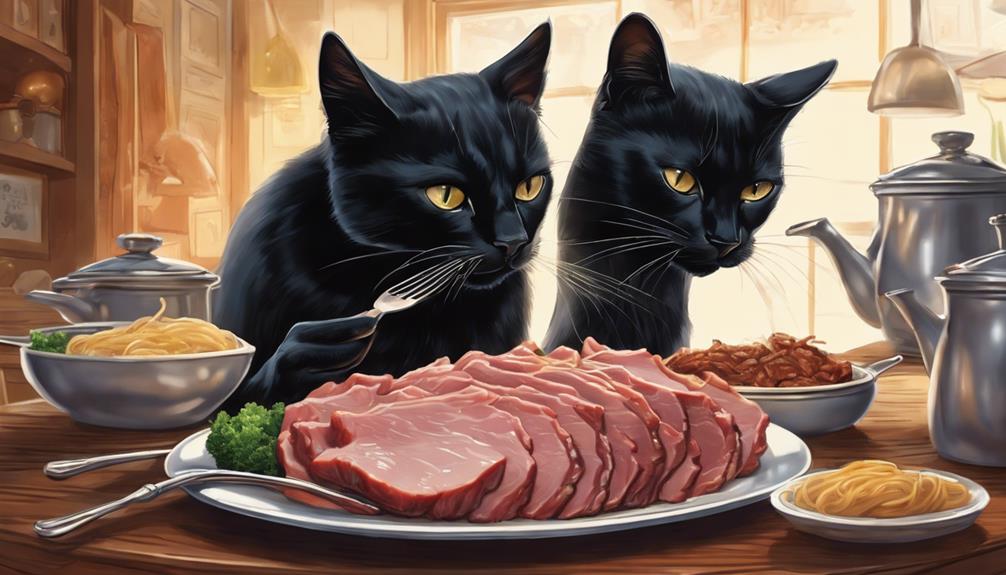
High fat content in pork poses a potential risk to the health of cats if consumed excessively. Cats struggle to process high-fat diets, making pork with elevated fat content a concern.
Excessive fat intake from pork can lead to obesity, pancreatitis, and various health issues in cats. Opting for leaner cuts of pork is advisable to mitigate the negative impact of fat content on your feline friend.
By monitoring the fat content in pork and controlling portions, you can help guarantee the safety of incorporating pork into your cat's diet. Remember, moderation is key when it comes to feeding your cat pork.
Choosing leaner options and being mindful of how much pork they consume can help prevent potential health complications associated with high fat intake. Keep your cat's well-being in mind and make informed decisions regarding their diet to promote a healthy and happy life.
Pork Sodium Levels in Cats
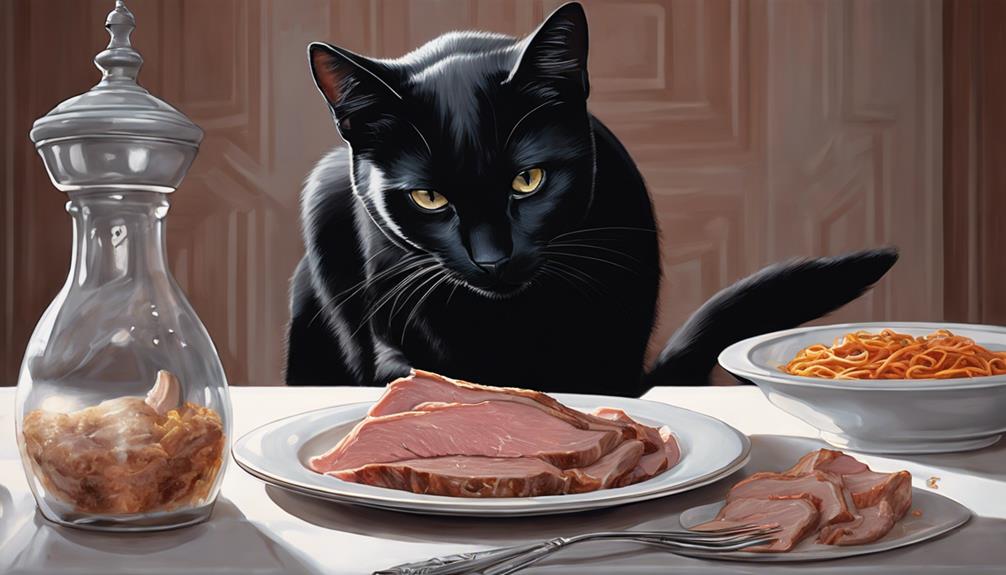
High sodium levels in pork can pose risks to our feline friends, affecting their liver, kidneys, and heart. Cats' sensitivity to excessive sodium underlines the significance of moderation when incorporating pork into their diet.
Monitoring sodium intake from pork is vital in safeguarding the well-being of our beloved cats.
Sodium Risks for Cats
With its high sodium content, pork poses a significant risk to cats' liver, kidneys, and heart, potentially leading to serious health issues. Cats' organs can be stressed by the excessive sodium intake from high-sodium pork, causing detrimental effects on their well-being. It's vital to monitor the sodium levels in their diet to prevent any adverse health consequences.
- Health Issues: Excessive sodium from pork can lead to health problems in cats.
- Organ Stress: Regular consumption of high-sodium pork can stress cats' organs.
- Sensitivity: Cats are sensitive to sodium levels, making high-sodium pork risky for their health.
- Prevention: Monitoring sodium intake from pork is essential to safeguard cats' health.
Pork and Felines
When considering the impact of pork on felines, it's important to be mindful of the high sodium levels present in this meat. Excessive sodium intake from pork can have detrimental effects on our cats' liver, kidneys, and heart, potentially leading to health issues like obesity and blocked arteries.
It's essential to remember that pork bones should be avoided as they don't aid in oral hygiene and pose a choking hazard to our furry friends. Feeding cats pork with high sodium levels may even result in salt poisoning, so moderation is key.
Cat Dietary Concerns
Considering the importance of sodium levels in pork on feline health is vital when addressing cat dietary concerns. Cats are sensitive to high sodium content, which can lead to a variety of health issues like obesity, blocked arteries, and even salt poisoning.
To guarantee your feline companion stays healthy and happy, it's essential to monitor their pork intake carefully. Avoid feeding them pork bones, as they don't benefit their oral hygiene and can pose choking hazards.
Lean Pork Cuts for Cats
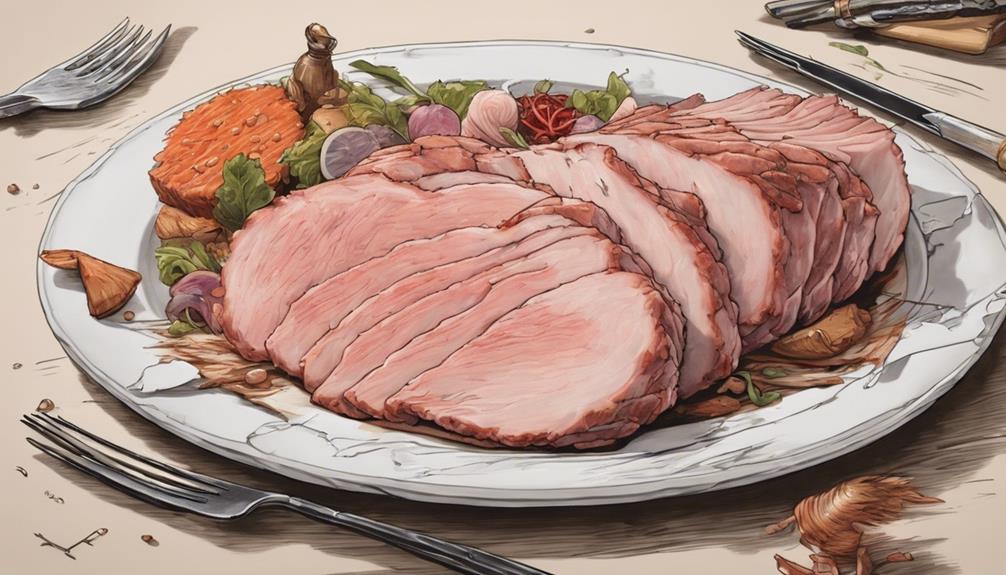
Lean pork cuts like tenderloin or loin chops provide a healthier option for cats by reducing their intake of excessive fat. Opting for fresh, organic pork guarantees a safe and nutritious choice for our feline friends.
When preparing pork for cats, be sure to eliminate all bones to prevent any choking hazards. Slow-cooking these lean cuts can aid in proper digestion and enhance the taste for our discerning companions.
While ham can be given in moderation, its salty and fatty nature should be taken into consideration. By selecting high-quality lean pork cuts and following proper preparation methods, we can offer our cats a tasty and nutritious treat that aligns with their dietary needs.
Avoiding Cured Pork for Cats
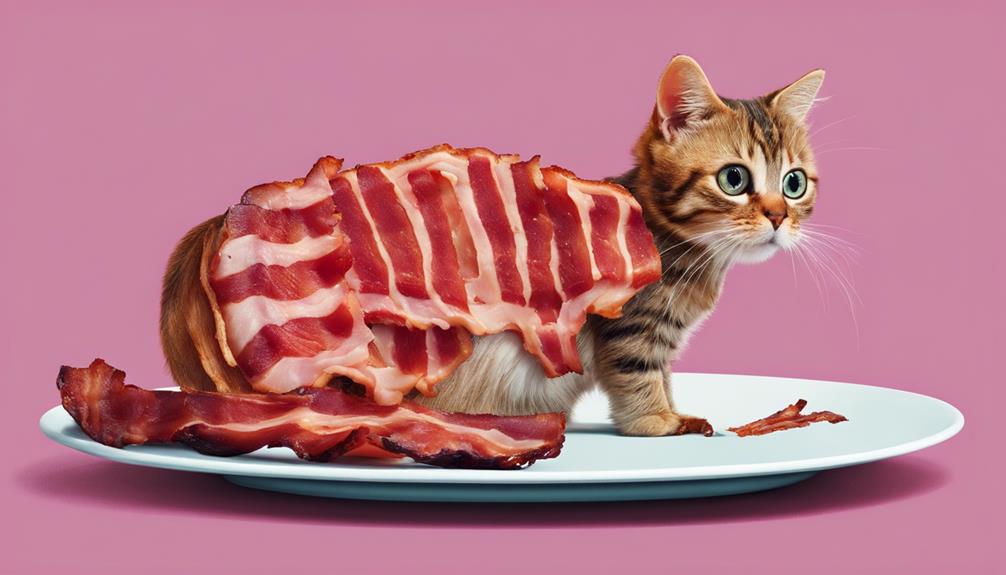
When it comes to our feline friends, it's important to avoid cured pork products like bacon and ham due to their high salt and fat content. These can lead to kidney issues and dehydration in cats, along with potentially harmful preservatives and additives.
Opting for fresh, unprocessed lean pork cuts is the way to go to guarantee your cat's safety and well-being.
Fresh Pork Preferred
Choosing fresh pork over cured pork is recommended for cats due to its lower salt and fat content. Fresh pork provides essential nutrients without the added preservatives found in cured pork, making it a healthier option for your feline friend. When feeding your cat pork, go for unprocessed cuts to guarantee a balanced diet without unnecessary additives.
- Fresh pork is lower in salt content, which is beneficial for cats' health.
- Essential nutrients in fresh pork support your cat's overall well-being.
- Cured pork products often contain additives that may not be suitable for cats.
- Opting for unprocessed pork ensures a natural and wholesome choice for your cat's diet.
Watch Out for Seasonings
Be cautious when seasoning pork for your cat to prevent any potential digestive issues. Seasonings can upset your cat's stomach, so it's best to stick to plain, unseasoned pork cuts.
When it comes to cured pork like bacon, it's important to steer clear. Cured pork is high in salt and fat, which can be harmful to your feline friend. Opt for lean, unprocessed pork options to guarantee a safe treat for your cat.
Cured pork products often contain additives that may not sit well with your cat's digestive system if consumed regularly. By selecting the right kind of pork and avoiding seasonings, you can treat your cat to a tasty and safe meal without any worries.
Consulting Vet Before Feeding Pork
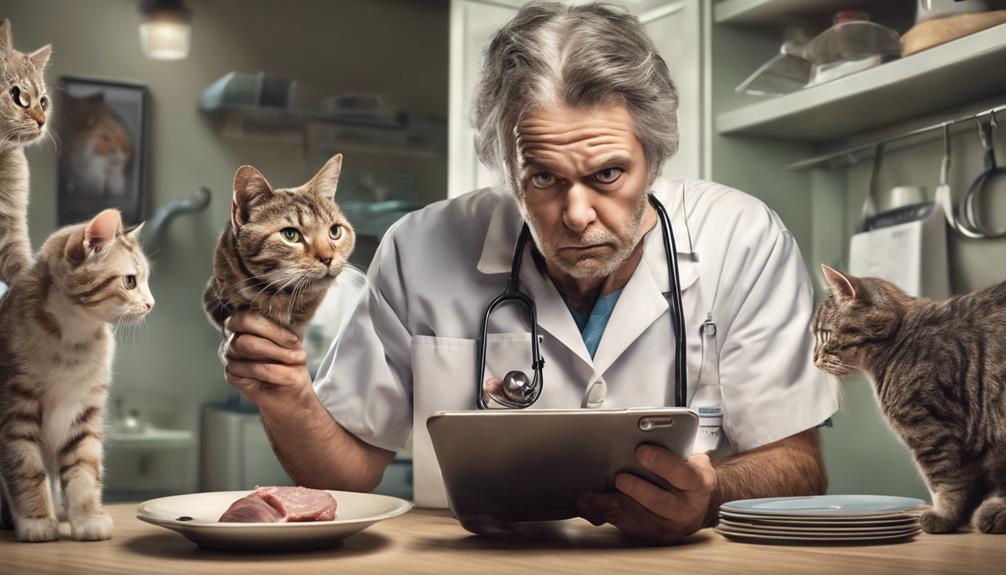
Before feeding pork to our cats, it's crucial to consult a vet to make sure their health and dietary requirements are taken into consideration. Vets play an essential role in offering personalized advice tailored to your cat's specific needs, including age and health conditions. They can recommend safe portions of pork to prevent any potential health risks and ensure that it complements your cat's overall nutrition.
Additionally, vets can guide you on the proper preparation methods for pork, ensuring that it's safe for consumption. Seeking professional veterinary guidance not only helps in making informed decisions about introducing pork into your cat's diet but also provides reassurance that you're prioritizing your cat's well-being. Remember, a vet's expertise is invaluable when it comes to understanding how to best care for your feline friend.
Moderation in Pork Feeding

When it comes to feeding pork to cats, remember that moderation is key. Keeping an eye on portion control, monitoring for any potential allergies, and making sure the meat is thoroughly cooked are all vital steps.
Portion Control Importance
Maintaining proper portion control when feeding pork to cats is crucial to prevent health issues such as obesity and digestive problems. Cats can enjoy pork as a treat, but overfeeding can lead to unwanted consequences. To guarantee your feline friend stays healthy and happy, remember these important points:
- Portion control: Always measure the amount of pork you give to your cat.
- Overfeeding risks: Excessive pork consumption can result in obesity.
- Balanced diet: Limit pork treats to occasional indulgences for a well-rounded diet.
- Moderation is key: Following the 10% rule for treats helps prevent calorie overload.
Monitor for Allergies
To safeguard your cat's well-being, it's important to monitor for any signs of allergies or adverse reactions when introducing pork into their diet. Cats can eat pork, but it's vital to be attentive to their responses.
Start with small portions and observe their behavior closely. Look out for symptoms like vomiting, diarrhea, or any unusual changes after feeding them pork. While allergic reactions to pork are rare in cats, it's still necessary to be cautious.
If you notice any negative reactions, such as itching or digestive issues, consult a veterinarian promptly. They can provide guidance on alternative protein sources that are safe for your furry friend.
Cook Thoroughly Before Feeding
Cooking pork thoroughly before feeding it to your cat is crucial to eliminate potential health risks. When considering pork as a treat for your feline friend, keep in mind the importance of moderation. Here are some key points to remember:
- Cook the pork: Make sure the pork is fully cooked to avoid any harmful bacteria.
- Moderation: Offer pork to your cat in small amounts to prevent health issues.
- Health risks: Excessive consumption of pork can lead to digestive problems.
- Occasional treat: Reserve pork as an occasional indulgence rather than a regular part of their diet.
Essential Nutrients for Cats

When considering essential nutrients for cats, one must prioritize protein, taurine, and vitamins typically found in meat-based diets. Protein is important for muscle growth and overall health in cats, providing essential amino acids necessary for their well-being.
B vitamins, also abundant in meat sources like pork, play an important role in various bodily functions, contributing to a cat's energy levels and metabolism. Taurine, another key nutrient found in pork, is essential for heart function and vision in felines. This amino acid is particularly significant as cats can't produce it sufficiently on their own.
Including pork in moderation can offer a complete protein source that supports muscle growth and tissue repair in cats, diversifying their diet and providing additional nutrients beneficial for their overall well-being. Ensuring a balanced intake of these essential nutrients is fundamental in promoting a healthy and thriving feline companion.
Taurine Importance for Cats

Taurine is an important amino acid for cats, necessary for their heart function, vision, and overall well-being. Without enough taurine in their diet, cats can suffer from severe health issues like heart disease and vision problems.
Ensuring your feline friend gets adequate taurine through their diet is essential for their long-term health and happiness.
Taurine Deficiency Risks
Understanding the essential role of taurine in a cat's diet is vital for preventing serious health issues. Cats rely on taurine from their food as they can't produce enough on their own. Without sufficient taurine intake, cats can develop heart disease and vision problems.
To make sure your feline friend stays healthy, it's important to provide a balanced diet that includes taurine-rich foods like chicken and fish, which are superior sources compared to pork. Remember, taurine is a non-negotiable nutrient for cats' overall well-being.
Here are some key points to take into account:
- Taurine deficiency can lead to heart disease and vision problems.
- Cats need taurine from their diet as they can't produce enough.
- Taurine-rich foods like chicken and fish are essential for a balanced diet.
- Pork isn't a significant source of taurine for cats.
Taurine Supplementation Benefits
To guarantee peak health for our cat friends, it's important to acknowledge the advantages of adding taurine in their diet. Taurine supplementation is essential because it's an essential amino acid that cats require for proper functioning.
Without enough taurine, cats can develop serious health issues such as heart problems and vision impairment. Since cats can't produce taurine on their own, it's vital to make sure they receive an adequate amount through their food.
Commercial cat foods are often fortified with taurine to prevent taurine deficiency and the associated health risks. By including taurine in our cats' diet, we can help them maintain optimal health and prevent potential complications related to taurine deficiency.
Muscle and Bone Growth in Cats

Ensuring proper muscle and bone growth in cats relies heavily on their high protein intake from meats like pork. Cats require essential amino acids found in pork, such as taurine, to support muscle development. Lean cuts of pork can aid in healthy muscle growth for our feline friends. Additionally, the high protein levels in pork are critical for maintaining strong bones in cats. Providing a balanced meat-based diet, including pork, is essential for promoting overall health and growth in cats.
When considering the muscle and bone growth of our beloved cats, it's important to remember the significance of including pork in their diets. By offering lean pork cuts, we can help them develop and maintain strong muscles and bones. This type of meat provides the necessary nutrients for their bodies to thrive. Remember, a well-rounded diet that includes pork can contribute to your cat's long-term health and well-being.
Benefits of Lean Pork for Cats
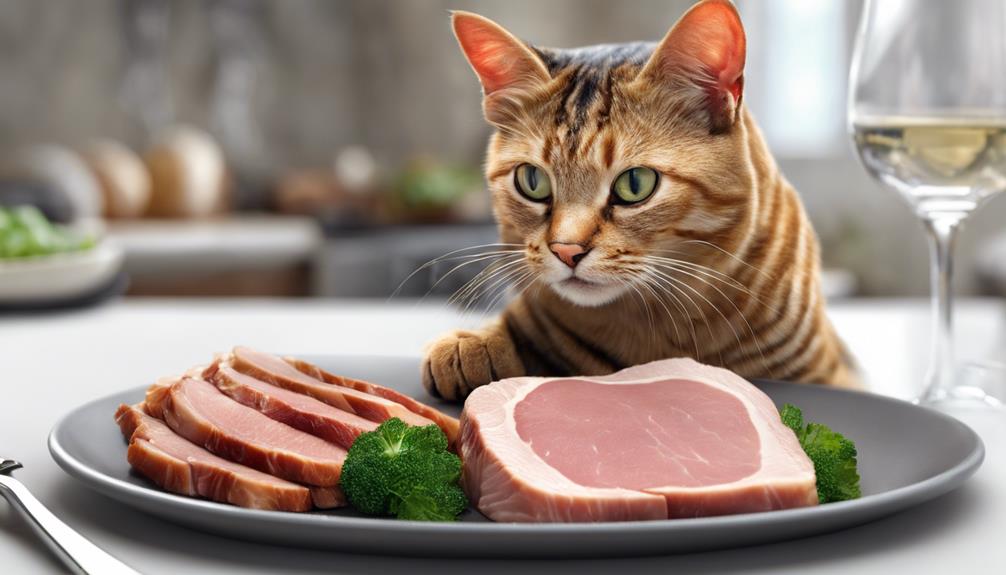
Lean pork provides crucial high-quality protein for cats, aiding in their muscle development and tissue regeneration effectively. Moreover, pork is brimming with vitamins and minerals like B vitamins, niacin, zinc, potassium, and selenium, all of which contribute to your feline companion's overall well-being. For example, the presence of vitamin B12 in pork can help enhance your cat's nervous and immune systems, supporting their health.
| Advantages of Lean Pork for Cats | |
|---|---|
| High-Quality Protein | Supports muscle development and tissue regeneration. |
| Vitamins and Minerals | Vital B vitamins, niacin, zinc, potassium, and selenium for overall well-being. |
| Occasional Treats | Introduces variety to their diet and functions as a valuable reward. |
| Cooked Properly | Guarantees a nutritious and enjoyable addition to their meals. |
Potential Risks of Pork Consumption
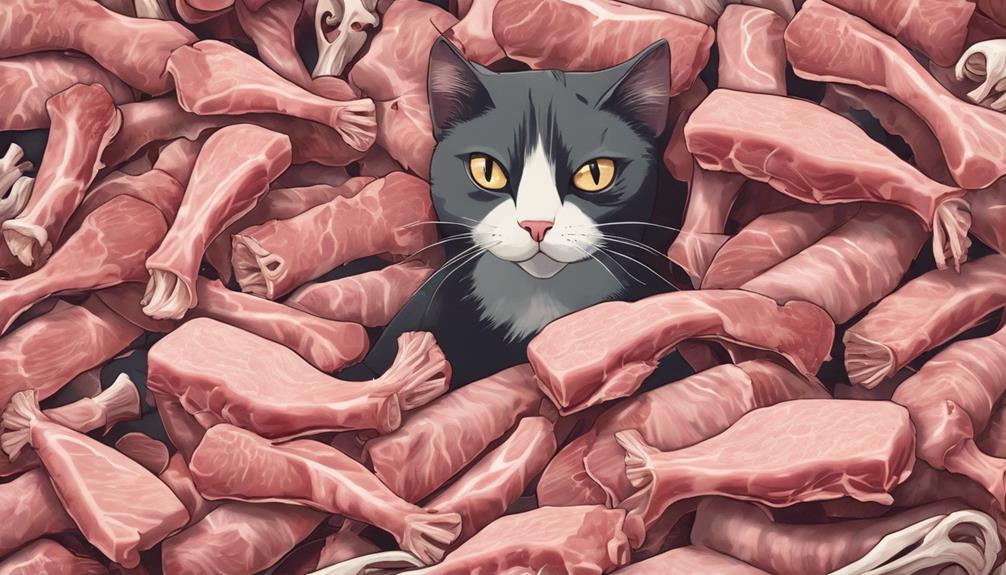
Sometimes, cats may face potential risks from consuming pork, particularly due to its high fat content and sodium levels. As obligate carnivores, cats aren't equipped to handle the high fat content found in pork, which can lead to unhealthy weight gain and potential health risks.
Additionally, the high sodium levels in pork can put stress on their liver, kidneys, and heart over time. When feeding cats pork bones, it's vital to note that it doesn't improve oral hygiene and poses a choking hazard instead.
To mitigate these risks, it's important to verify that pork is cooked thoroughly before offering it to your feline friend. By being aware of these potential dangers associated with pork consumption, we can better care for our beloved cats and prioritize their well-being.
Incorporating Pork in Cats Diet

How can pork be safely incorporated into a cat's diet while prioritizing their health and well-being?
When considering adding pork to your feline friend's menu, choose lean cuts such as tenderloin or loin chops. Confirm the pork is fully cooked and free from any seasonings that could upset your cat's stomach.
Remember, moderation is key when it comes to pork treats. Limit the amount to 1-3 small pieces per serving to prevent overconsumption. Treats should make up no more than 10% of your cat's daily calorie intake, so offering pork as a treat once a week or less is ideal for maintaining a balanced diet.
Understanding Cats Pork Tolerance
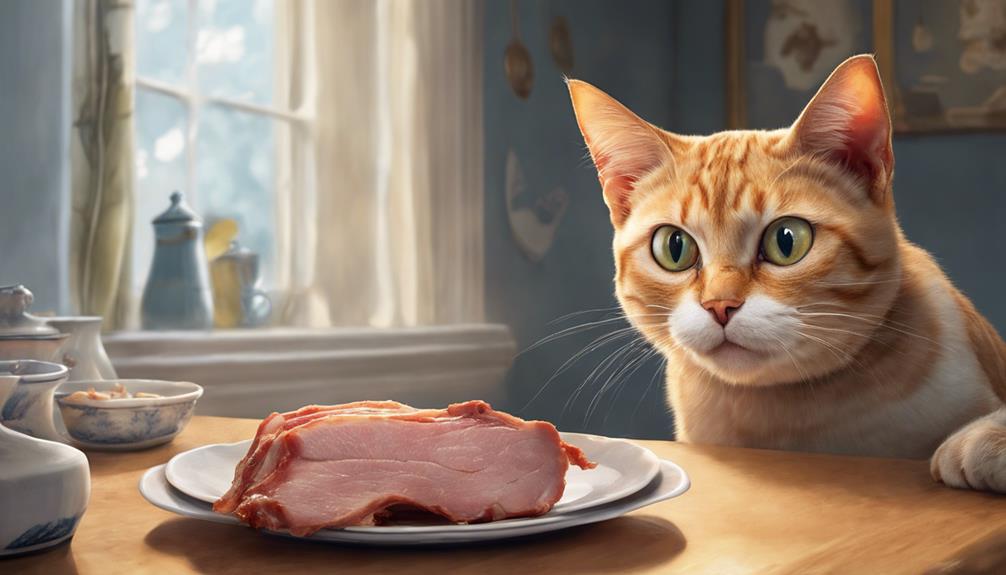
When considering cats' tolerance for pork, it's important to acknowledge their carnivorous nature and the benefits of incorporating this protein source into their diet. Cats can safely eat cooked pork, which provides essential protein for their carnivorous diet. However, raw pork should be avoided as it may contain harmful parasites and bacteria that can negatively impact cats' health.
Here are some key points to remember when feeding your cat pork:
- Cats eat cooked pork for essential protein.
- Raw meat should be avoided due to potential health risks.
- Feeding your cat pork in moderation can add variety to their diet.
- Cooked pork is safe for cats and offers essential nutrients.
Monitoring Cats Reaction to Pork

After understanding cats' pork tolerance, it's crucial to monitor their response to this protein source to guarantee their well-being and health. Keep a close eye on your feline friend for any signs of digestive issues or allergies that may arise after consuming pork.
Watch out for symptoms such as vomiting, diarrhea, lethargy, or changes in appetite. By monitoring your cat's reaction to pork, you can ascertain if it's well-tolerated or if it should be avoided in the future. Note any unusual behaviors or health concerns that might occur post-pork consumption.
Frequently Asked Questions
Why Can't Cats Eat Pork?
We avoid feeding cats pork due to splintering bones causing choking hazards, high sodium and fat content leading to health issues, potential parasites and bacteria, toxic seasonings, obesity risks, and blocked arteries. It's better to stick to cat-friendly foods.
What if My Cat Accidentally Ate Pork?
If my cat accidentally ate pork, we would monitor for symptoms like vomiting or diarrhea. If concerning signs appear, we'd contact our vet promptly. It's important to track the amount eaten and avoid giving pork intentionally to prevent health risks.
Is Any Meat Bad for Cats?
Any meat can be bad for cats if consumed in excess. While pork is not inherently harmful, its high fat and sodium content can lead to health issues. Moderation is key to keeping our feline friends healthy.
Is Pork Bad for Dogs or Cats?
Pork can be harmful to cats due to its high fat and sodium content. It may lead to obesity and health issues. It's best to avoid pork in a cat's diet and opt for healthier alternatives.
Is it Safe for Cats to Eat Pork if They Shouldn’t Eat Grape Stems?
Cats and grape stems should be kept apart as grapes are toxic to felines. However, pork can be safe for cats in moderation. It provides essential nutrients like protein and taurine. Always thoroughly cook pork before feeding it to your cat to reduce the risk of foodborne illness.
Conclusion
To sum up, while cats can safely eat pork in moderation, it's important to be mindful of the risks associated with certain cuts and preparations.
Like a delicate dance, understanding your feline friend's tolerance to pork and monitoring their reaction is key to incorporating this protein into their diet safely.
Remember, a balanced diet is like a symphony – each ingredient playing its part to keep your furry companion healthy and happy.
